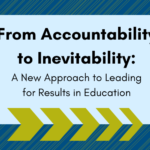I love my mom. So when she was in town on a day when I was teaching scatter plots to my students, I was so excited to blow her mind with a ridiculously engaging lesson. I had yarn, scissors, and yardsticks, and I had students use these materials (anyway they chose) to create a scatter plot that determined whether there was a relationship between height and the size of your head. I also had my instructional coach randomly observing me that day as well.
Want to bring thinkLaw to your school? Click here to get a custom quote for within 48 hours.
Students were on task the entire time. They had so much fun figuring out how to design this experiment. They worked together, ultimately deciding to break into groups of four, wrap the yarn around each student’s forehead to have consistent measurements, and use extra-long pieces of yarn to measure each students’ height. And then once they had the class data on the scatter plot, they did a best fit line and used the equation of that line to predict what the size of my head would be (abnormally large of course), they completed an exit slip about a best-fit line, and then class was over. Students exclaimed on their way out how much easier it is to learn when they do hands-on activities, and my coach also gave me great feedback.
Needless to say, my mom was not impressed.
And when I saw the exit slips, neither was I. Her statement, “[j]ust because they were having fun doesn’t mean they were learning anything” offended me at first. You know how awesome I looked that day? That could have be one sample lesson I did for evaluations that would give me all 4s every time! But in reality, I made the mistake so many educators make when they plan and deliver instruction, and so many principals make when they observe teachers: I confused engagement with learning.
Engaged students who are on-task, having fun, and working together on hands-on activities are not necessarily engaging in critical thinking. Since so many principals are spending the next few weeks wrapping up their end of year evaluations by making in-person observations, here are 5 questions principals can ask to ensure they accurately assess critical thinking instruction:
1. Are your teacher’s questions truly higher-order, or are they just difficult?
My head size v. height activity was an example of a lesson that involved a lot of steps, but other than relatively intuitive experimental design process, the actual steps involved were very simple. On the other hand, if I spent some time having students predict what the best-fit line would be like before starting, they could figure that out quickly, but this would be close to the higher end of Bloom’s Taxonomy. Don’t let complex tasks trick you into assuming that critical thinking is happening.
2. Are the learning activities creating “lightbulb” moments for students?
There is a huge difference between project-based learning and activities that are just projects. I’m reminded of a colleague who designed a lesson to help students understand what Industrial Age-era factories were like through a project that required them to create something using an assembly line. She was frustrated because the lessons became all about the insignificant thing they were creating, not the deeper meaning she was trying to get students to understand about the working conditions at the time. But when she set it up differently, given students different roles on the labor, management, and scab side of a workplace dispute, we saw actual learning happening, with students walking way with lots of “lightbulb” moments where the complex challenges of that era came to life. Principals, look for this in your observations.
3. Are teachers giving students space to take risks?
It feels great to walk into a classroom and see student after student raising their hands and giving their teachers the correct answers to questions. And yet, this is one of the key indicators that critical thinking instruction is not happening because the teacher is not creating enough room to allow students to make intellectual risks. Deeper learning requires deeper questions than those that give you a simple right or wrong answer. So as impressive as it would be to see students correctly identify capital cities around the world, it’s a much riskier and rigorous inquiry to have students compare and contrast patterns and trends regarding the location of capital cities. And should students identify one popular trend, where capital cities are often located near major ports, for instance, having students evaluate the appropriateness of keeping capitals there, especially for countries located at sea level facing challenges of global climate change and extreme weather. Very few right or wrong answers here, but lots of opportunity for students to get in the habit of taking risks to make claims, and then accessing facts to back their claims up.
4. Is the teacher giving students enough time to think deeply before they respond or complete their learning activities?
Every classroom has its gunners, those students whose hands shoot up in the air before a teacher even finishes the question. But even these students could benefit from intentional thinking periods teachers give them before responding. When teachers wrap up Of Mice and Men and they ask the powerful question of whether George was justified in killing his best friend Lennie (spoiler alert), they should explicitly give students time to think about the answer. “Don’t start responding, don’t talk, just think.” This strategy is something I really never saw until law school, where we had several four hour final exams where the professor expected us to use the entire first hour to plan out our essay answer before we started writing. Imagine a world where our young people, as a habit, stopped to reflect before making an important decision. Probably a good habit to start practicing early, so please keep your eyes open for this precious wait time.
5. Are you, the observer, making enough visits to assess whether this teacher is regularly incorporating strategies to increase student critical thinking skills, habits, and mindsets?
One observation is never going to give you the information you need to assess whether a teacher is adequately delivering critical thinking instruction. It’s far easier to make one visit and see that a teacher is teaching critical thinking skills. But, as noted in an article focused on what teachers can do to ensure that critical thinking is no longer a luxury good, true critical thinking requires more than just skills. Our students need the habits and mindsets to actually apply these skills, regularly, throughout their academics, lives, and careers. So whether you are using innovative video tools to observe more classroom activity or doing a deeper dive into teacher lesson plans, make sure you have a pulse on how frequently teachers are delivering critical thinking instruction to students, with once a week being a minimum benchmark.
Principals, try asking these questions and let me know what you think. I’m sure my mom would approve! Please share and add any other thoughts you might have about questions to ask in the comments below. If you’d like a quicker, video overview of this post click here.










Leave a Reply